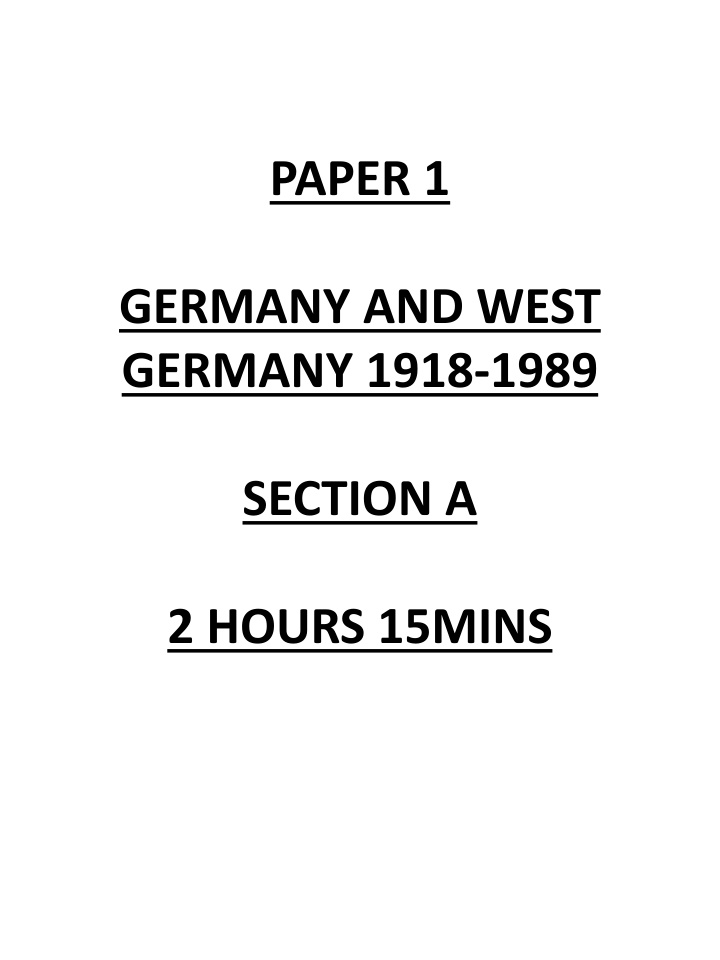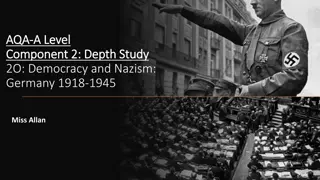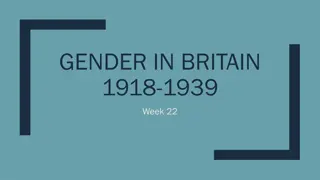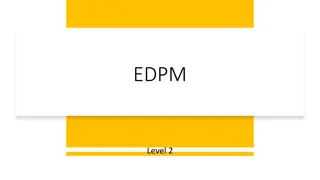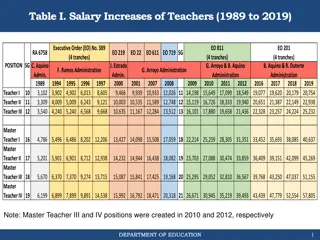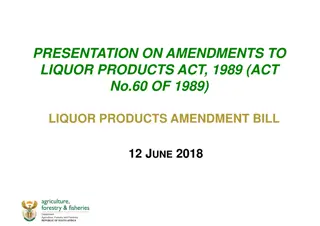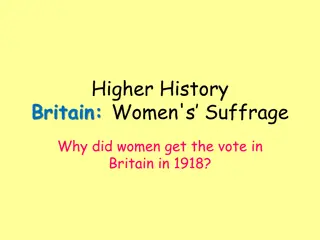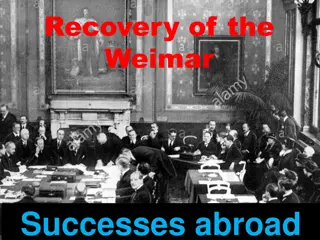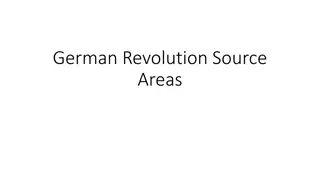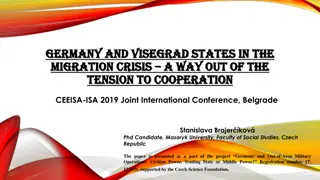Germany and West Germany 1918-1989: Paper 1 Assessment Overview
This content provides information about the Paper 1 assessment on Germany and West Germany from 1918 to 1989. It includes question types, assessment structure, marking schemes, and aims to help students understand the focus areas and concepts of the assessment. The assessment covers political, social, and economic aspects of the period, aiming to evaluate students' understanding of key historical developments and changes.
Download Presentation

Please find below an Image/Link to download the presentation.
The content on the website is provided AS IS for your information and personal use only. It may not be sold, licensed, or shared on other websites without obtaining consent from the author.If you encounter any issues during the download, it is possible that the publisher has removed the file from their server.
You are allowed to download the files provided on this website for personal or commercial use, subject to the condition that they are used lawfully. All files are the property of their respective owners.
The content on the website is provided AS IS for your information and personal use only. It may not be sold, licensed, or shared on other websites without obtaining consent from the author.
E N D
Presentation Transcript
PAPER 1 GERMANY AND WEST GERMANY 1918-1989 SECTION A 2 HOURS 15MINS
QUESTION TYPES To what extent was FACTOR the main cause/reason for SUBJECT? Cause By 1914, the FACTOR had made it into one of the most important SUBJECT. How far do you agree? Consequence To what extent did the SUBJECT characterise the SUBJECT in the years 1918-1945? Continuity and change / comparative / patterns of change How accurate is it to say that the SUBJECT was significantly different from that of the SUBJECT? Similarities and differences / comparative / patterns of change The FACTOR was the most significant reason in the improvement of SUBJECT that led to SUBJECT. How far do you agree? Significance / turning point
PAPER 1 GERMANY AND WEST GERMANY 1918-1989 ASSESSMENT 2 HOURS 15MINS Students answer three questions - one from each section SECTION A (AE) - BREADTH FOCUSED ESSAY Choice of two essay questions 20 MARKS The focus of study is on Germany and West Germany; developments and changes over a broad timescale and so the content is presented as themes spanning a significant duration: 1918 89. Theme 1: Political and governmental change Theme 2: Opposition, control and consent Theme 3: Economic development and policies Theme 4: Life in Germany and West Germany (social) Questions may cross the themes but focus on a specific period i.e. at least 10 years Target concepts (AO1) causation, consequence, change, continuity, similarity, difference, or significance
AIMING HIGH - SECTION A and B (BREADTH) MARK-SCHEME Simple or generalised statements are made about the topic. Some accurate and relevant knowledge is included, but it lacks range and depth and does not directly address the question. The overall judgement is missing or asserted. There is little, if any, evidence of attempts to structure the answer and the answer overall lacks coherence and precision. L1 1-3 There is limited analysis of some key features of the period relevant to the question, but descriptive passages are included that are not clearly shown to relate to the question. Mostly accurate and relevant knowledge is included, but it lacks range or depth and has only implicit links to the demands and conceptual focus of the question. An overall judgement is given but with limited substantiation and the criteria for judgement are left implicit. The answer shows some attempts at organisation, but most of the answer is lacking in coherence, clarity and precision. L2 4-7 There is some analysis of, and attempt to explain links between, the relevant key features of the period and the question, although descriptive passages may be included. Mostly accurate and relevant knowledge is included to demonstrate some understanding of the demands and conceptual focus of the question, but material lacks range or depth. Attempts are made to establish criteria for judgement and to relate the overall judgement to them, although with weak substantiation. The answer shows some organisation. The general trend of the argument is clear, but parts of it lack logic, coherence and precision. L3 8-12 Key issues relevant to the question are explored by an analysis of the relationships between key features of the period, although treatment of issues may be uneven. Sufficient knowledge is deployed to demonstrate understanding of the demands and conceptual focus of the question, and to meet most of its demands. Valid criteria by which the question can be judged are established and applied in the process of coming to a judgement. Although some of the evaluations may be only partly substantiated, the overall judgement is supported. The answer is generally well organised. The argument is logical and is communicated with clarity, although in a few places it may lack coherence and precision. L4 13-16 Key issues relevant to the question are explored by a sustained analysis of the relationships between key features of the period. Sufficient knowledge is deployed to demonstrate understanding of the demands and conceptual focus of the question, and to respond fully to its demands. Valid criteria by which the question can be judged are established and applied and their relative significance evaluated in the process of reaching and substantiating the overall judgement. The answer is well organised. The argument is logical and coherent throughout and is communicated with clarity and precision. L5 17-20
Section A GERMANY AND WEST GERMANY Weimar Years 1918-1933 Was the work of Stresemann the main reason for the Weimar government s ability to overcome the challenges it faced between 1919 and 1929? How far do you agree that opposition to the Weimar government in the years 1918-1932 was rooted in a hatred of the Treaty of Versailles? How accurate is it to say that the years 1918 to 1929 were a period of economic disruption followed by a period of stability and consolidation? How accurate is it to say that von Papen was responsible for Hitler s appointment as chancellor in January 1933? Were political divisions the main reason for the failure of the Weimar Republic in the years 1919-1933? Was outrage over the Treaty of Versailles the main reason for opposition to the Weimar Republic in the years 1919-1932? How accurate is it to say that the Weimar Republic never enjoyed widespread popular support? How far do you agree that the Weimar Republic faced severe economic and political challenges in the years 1918-1932? To what extent did the Dawes Plan affect the economy of and standard of living in the Weimar Republic in the 1920s? How far do you agree that economic problems were responsible for political instability in the Weimar Republic in the years 1918-1932? How accurate is it to say that the Weimar Republic was a democratic society in the years 1918-1932? To what extent does the Treaty of Versailles explain the political extremism in Germany in the years 1919-1932? How accurate is it to say that political opposition from the extreme right was the most significant threat to the stability of the Weimar Republic in the years 1919-1929?
Section A GERMANY AND WEST GERMANY Third Reich 1933-1945 Was popular support for Hitler the main reason for the lack of effective opposition to the Nazi regime in the years 1933 45? Were improved living standards the main consequence of German economic policies in the years 1933 45? How accurate is it to say that Hitler s rise to becoming a dictator was achieved by legal means? Was the main reason for popular support for the Nazis in the years 1933-1945 the party s use propaganda? Was the recovery of the German economy the main reason for the survival of the Nazi regime in the years 1933-1939? How far was the legal revolution responsible for the growth of Hitler s power within the German government in the years 1933- 45? How accurate is it to say that repression and terror were the fundamental reason for the survival of the Nazi regime in the years 1933-1945? How accurate is it to say that Nazi economic policy changed radically in the years 1933-1945? How effective was the Nazi government in manging the economy in the years 1933-1945? How accurate is it to say that the Nazis created a totalitarian regime in the years 1933-1945? How accurate is it to say that Nazi racial policy became consistently more radical in the years 1933-1945
Section A GERMANY AND WEST GERMANY Federal Republic of Germany 1945-1989 How significant was the contribution of Adenauer in the establishment of a stable political base in the FRG in the years 1949-1989? Was unemployment the main reason for the varying treatment of minorities in the FRG between 1960 and 1989? How far was Konrad Adenauer responsible for the stability of the Federal Republic of Germany in the years 1949-1989? How extensive was political dissent in the Federal Republic of Germany in the years 1949-1989? To what extent did political dissent occur in the Federal Republic of Germany in the years 1919-1989? The post-war economic history of West Germany was one of constant success. How far do you agree with the statement.? How accurate is it to say that following 1945 the economy of the Federal Republic of Germany was continually successful? How far was the social market economy responsible for the economic success of eth Federal Republic of Germany in the years 1949-1989? How accurate is it to say that women made substantial gains in their position and status in the years 1949-1989? How accurate is it to say that there was a sustained increase in living standards in the Federal Republic in the years 1949-1989? How far do you agree that the Federal Republic faced serve economic and political challenges in the years 1965-1983?
PAPER 1 GERMANY AND WEST GERMANY 1918-1989 SECTION B 2 HOURS 15MINS
PAPER 1 GERMANY AND WEST GERMANY 1918-1989 ASSESSMENT 2 HOURS 15MINS Students answer three questions - one from each section SECTION B (AE) - BREADTH COMPARISON ESSAY Choice of two essay questions 20 MARKS The focus of study is on Germany and West Germany; developments and changes over a broad timescale and so the content is presented as themes spanning a significant duration: 1918 89. Theme 1: Political and governmental change Theme 2: Opposition, control and consent Theme 3: Economic development and policies Theme 4: Life in Germany and West Germany (social) Questions may cross the themes via a comparison of two periods Target concepts (AO1) causation, consequence, change, continuity, similarity, difference, or significance
Section B - Comparison Question: Political and governmental change 1918-1989 How far would you agree with the view that the stability of the Federal Republic of Germany was mainly achieved by avoiding the constitutional problems of the Weimar Republic? How accurate is it to say that the system of government in Nazi Germany in the years 1933-1939 was significantly different from that of the Weimar Republic? To what extent was the system of democracy practised in the Federal Republic similar to that of the Weimar Republic? How accurate is it to say that in the years 1933-1965 the government of Germany and the Federal Republic of Germany was stable and successful? How accurate is it to say that there were major changes in the nature of the German government in the years 1919-1945? How accurate is it to say that the nature of the government of the Federal Republic in the years 1949-1989 was fundamentally different from that of the Nazi government? How far do you agree that the nature of the government of the Federal Republic in the years 1949-1969 was completely different from that of the Nazi regime?
Section B - Comparison Question: Opposition, control and consent, 1918-1989 How far do you agree that anti-government protest changed completely between 1933 and 1989? How accurate is it to say that the years 1918-1933 and 1949- 1989 gave Germans two very different experiences of democracy? How effective was political opposition to German governments in the years 919-1945? Section B - Comparison Question: Economic Development and policies, 1918-1989 To what extent were attempts to create a command economy in Nazi Germany successful in solving the economic problems of the Weimar Republic?
Section B - Comparison Question: Aspects of life in Germany and West Germany, 1918-1989 How accurate is it to say that the role of German women continued to be that of wife and mother in the years 1933-89? How far do you agree that the Federal Republic saw a complete rejection of the traditional female role and stereotypes that had existed in Germany since 1918? To what extent did the Nazi regime overturn the Weimar education system? How significant was the period of Nazi rule in the development of cultural and generational tensions in the FRG? How far do you agree that the Nazi seizure of power led to a turning point in German education and culture in the years 1918-1934 How accurate is it to say that racism was a consistent feature of German politics in the years 1918 to 1945? To what extent were the cultural developments of the Weimar years suppressed by the Nazi regime?
PAPER 1 GERMANY AND WEST GERMANY 1918-1989 ASSESSMENT 2 HOURS 15MINS Students answer three questions - one from each section SECTION C (CA) - ASPECT IN DEPTH Historical interpretations: How far was Hitler s foreign policy responsible for the Second World War? The focus of study is on the main features of Nazi foreign policy in the years 1933 39, and the events leading to the outbreak of the Second World War. Students will need to know: The impact of both the defeat in the First World War and the consequences of the Versailles settlement on Nazi foreign policy. The extent to which Nazi foreign policy, 1933 39, was the result of a master-plan engineered by Hitler or the result of more pragmatic opportunism. The international situation in Europe and the weakness of the League of Nations Question will target CAUSATION, CONSEQUENCES and SIGNIFICANCE
PAPER 3 PROTEST, AGITATION AND PARLIAMENTARY REFORM IN BRITAIN 1780-1928 SECTION A 2 HOURS 15MINS
PAPER 3 - Protest, Agitation and Parliamentary Reform in Britain 1780-1928 ASSESSMENT - 2 HOURS 15MINS Students answer three questions - one from each section SECTION A - SOURCE QUESTION One compulsory question that assesses the ability to analyse and evaluate source material that is primary/contemporary to the period. 20 MARKS Source will be focused on a key topic from one of the five Aspects in Depth topics
ASPECTS IN DEPTH MASS PROTEST AND AGITATION IN ENGLAND 1780-1928 T1 RADICAL REFORMERS 1790-1819 aims, tactics and impact of extra-parliamentary protest; government responses; influence and role of individuals such as William Cobbett and Henry Hunt. T2 CHARTISM 1838-1850 Chartism s aims and actions; role of individuals such as Lovett and O Connor; fluctuations in public support; government responses T3 CONTAGIOUS DISEASES ACTS AND THE CAMPAIGN FOR THEIR REPEAL 1862-1886 why CDAs were introduced, impact on women and prostitutes; roles of individuals such as Josephine Butler and Wolstenholme; reasons for repeal of CDAs T4 THE WOMEN S SOCIAL AND POLITICAL UNION 1903-1914 WSPU organisation and tactics; roles of individuals such as Emily Davison and the Pankhurst's; government attitudes to female suffrage; extent of WSPU success T5 TRADES UNION MILITANCY 1915-1927 role of individuals such as Manny Shinwell and Ernest Bevin; events and significance of key strikes of 1915 and 1917; union revival after the First World War; the General strike 1926 and reasons for its occurrence and failure; Trades Disputes Act 1927
SECTION A (SOURCE ANALYSIS) MARK-SCHEME Demonstrates surface level comprehension of the source material without analysis, selecting some material relevant to the question, but in the form of direct quotations or paraphrases. Some relevant contextual knowledge is included, with limited linkage to the source material. Evaluation of the source material is assertive with little or no supporting evidence. Concepts of reliability or utility may be addressed, but by making stereotypical judgements. L1 1-3 Demonstrates some understanding and attempts analysis of the source material by selecting and summarising information and making undeveloped inferences relevant to the question. Contextual knowledge is added to information from the source material to expand, confirm or challenge matters of detail. Evaluation of the source material is related to the specified enquiry but with limited support for judgement. Concepts of reliability or utility are addressed mainly by noting aspects of source provenance and judgements may be based on questionable assumptions. L2 4-7 Demonstrates understanding of the source material and shows some analysis by selecting key points relevant to the question, explaining their meaning and selecting material to support valid inferences. Deploys knowledge of the historical context to explain or support inferences as well as to expand, confirm or challenge matters of detail. Evaluation of the source material is related to the specified enquiry and explanation of utility takes into account relevant considerations such as nature or purpose of the source material or the position of the author. Judgements are based on valid criteria but with limited justification. L3 8-12 Analyses the source material, interrogating the evidence to make reasoned inferences and to show a range of ways the material can be used, for example by distinguishing between information and claim or opinion, although treatment of the two sources may be uneven. Deploys knowledge of the historical context to illuminate and/or discuss the limitations of what can be gained from the content of the source material, displaying some understanding of the need to interpret source material in the context of the values and concerns of the society from which it is drawn. Evaluation of the source material uses valid criteria which are justified and applied, although some of the evaluation may be weakly substantiated. Evaluation takes into account the weight the evidence will bear as part of coming to a judgement. L4 13-16 Interrogates the evidence of both sources with confidence and discrimination, making reasoned inferences and showing a range of ways the material can be used, for example by distinguishing between information and claim or opinion. Deploys knowledge of the historical context to illuminate and/ or discuss the limitations of what can be gained from the content of the source material, displaying secure understanding of the need to interpret source material in the context of the values and concerns of the society from which it is drawn. Evaluation of the source material uses valid criteria which are justified and fully applied. Evaluation takes into account the weight the evidence will bear as part of coming to a judgement and, where appropriate, distinguishes between the degree of certainty with which aspects of it can be used as the basis for claims. L5 17-20
Section A Source Question 20 Marks Source Guidance SOURCE FORMAT The source will be a primary or contemporary source: it will have been written in 1780-1929, it will be approx. 350 words long and be accompanied by a brief passage which will set out the essential provenance of the source. The question will begin with the following stem: Assess the value of the source for revealing Assess the value - means you must evaluate how useful the source could be to a historian. Evaluating the extent of usefulness involves considering its value and limitations in the light of your own knowledge about the source s historical context; its values and assumptions of society from which it came form. The question focuses on two specific enquiries that the source might be useful for. Crucially both enquiries must be addressed in response. Important information about the context of the source is included in the provenance. THINGS TO DO .. Establish the general context of the source nature, origins and purpose; what was going on at the time, what are the key debates the source might be contributing to etc. Identify specific references to contemporary events, people or debates in the sources Look for key words and phrases that establish the specific context; people, events or books Make sure your contextualisation focuses on the question. Use the context when evaluating the usefulness and limitations of the source Establish a criteria objectivity, accuracy and how complete
Section A Source Question 20 Marks Writing Guidance PEEC Point - Determine a line of argument for either the first or second line of enquiry. BOTH ENQUIRIES MUST BE ADDRESSED IN RESPONSE OVERALL Evidence - Identify and quote the part of the source that supports the argument - Be specific to content, origin and/or nature Evaluation - Add historical context to confirm(L2) /explain(L3) /discuss(L4/5) source analysis point and evidence - and the link to relevant line of enquiry extents/inferences - here evaluate the strengths/limitations within historical context Challenge Question quality of source or argument does this effect reliability/value? Extent? A DEBATE MUST TAKE PLACE TO SUPPORT JUDGEMENT OF SOURCE(L4/5) BOTH GREAT EXTENT AND LESS EXTENT MUST BE ADDRESSED IN OVERALL RESPONSE BOTH LINES OF ENQUIRY MUST BE ADDRESSED IN OVERALL RESPONSE CONCLUSION IS IMPERATIVE DELIVER A SUSTAINED JUDGEMENT IN THE USEFULNESS (VALUE) OF THE SOURCE IN REALTION TO THE TWO ENQUIRIES.
A CLOSER LOOK AT SOURCE ANALYSIS LEVELS Level 2 Level 3 Level 4 Level 5 Source analysis Summarise and paraphrase source/ quotations Copy and select detail from sources and ability to explain quotation Making an inference based on quotation and ability to explain and analyse relevance Analyse the source in a sophisticated way; distinguish between information, opinions and arguments Historical context/own knowledge in relation to the source Used to expand or support the information in the source Used to explain, confirm and/or challenge details mentioned in the source Used to discuss inferences- the limitations and/or strengths of the details mentioned in the source Used to examine the value and limits of the material contained in the source by interpreting the source in the context of the values and assumptions of the period - what can be gained? Evaluation / extent of value Criteria cited but simplistic and so judgment on value is not justified Criteria established and judgements are clearly made against it but justification is not consistent. Criteria established and judgements bear in mind the weight of evidence provided to justify view nature and purpose of source Valid criteria established to inform judgments and justify extent of value of different aspects of the source
Depth Topic 1 Radical reformers 1790-1819 Assess the value of source A for revealing the behaviour of the crowd and the actions taken by the yeomanry. Explain your answer using the source, the information given about its origin and your own knowledge about the historical context.
Depth Topic 1 Radical reformers 1790-1819 Assess the value of source B for revealing radical arguments against hereditary systems of government and in favour of popular revolutions. Explain your answer using the source, the information given about its origin and your own knowledge about the historical context.
Depth Topic 1 Radical reformers 1790-1819 Assess the value of source C for revealing the behaviour of the crowd and of the authorities in St Peter s Field. Explain your answer using the source, the information given about its origin and your own knowledge about the historical context.
Edexcel pg 69 source A Edexcel pg 78 source B Baumann pg74 source c
Depth Topic 2 Chartism 1838-1850 Assess the value of source A for revealing the reasons why women were prepared to support the Chartist movement, and their attitude towards different social groups. Explain your answer using the source, the information given about its origin and your own knowledge about the historical context.
Depth Topic 2 Chartism 1838-1850 Assess the value of source B for revealing Napier s attitude towards the Chartists, and the strength of the Chartist organisation in 1839? Explain your answer using the source, the information given about its origin and your own knowledge about the historical context.
Edexcel pg 100 source A Edexcel pg 104 source B
Depth Topic 3 Contagious Diseases Acts and the campaign for repeal 1862-1886 Assess the value of source A for revealing William Acton s attitude towards the Contagious Diseases Acts and to the dilemma prostitution posed to the legislature. Explain your answer using the source, the information given about its origin and your own knowledge about the historical context.
Depth Topic 3 Contagious Diseases Acts and the campaign for repeal 1862-1886 Assess the value of source B for revealing anti-Contagious Diseases Act protestors attitude towards professional doctors and the attitudes of the government towards these same doctors. Explain your answer using the source, the information given about its origin and your own knowledge about the historical context.
Depth Topic 3 Contagious Diseases Acts and the campaign for repeal 1862-1886 Assess the value of source C for revealing the arguments put forward by the Ladies National Association for the repeal of the Contagious Diseases Acts. Explain your answer using the source, the information given about its origin and your own knowledge about the historical context.
Edexcel pg 112 source A Edexcel pg 120 source B Baumann pg103 source c
Depth Topic 4 The WSPU 1903-1914 Assess the value of source A for evaluating the attitudes of the WSPU leaders such as Sylvia Pankhurst towards the imprisonment of women and the variation in the treatment of women of different classes. Explain your answer using the source, the information given about its origin and your own knowledge about the historical context.
Depth Topic 4 The WSPU 1903-1914 Assess the value of source B for revealing WSPU attitudes towards the failure of parliament to pass legislation granting women the vote, and Emmeline Pankhurst s opinion regarding militancy. Explain your answer using the source, the information given about its origin and your own knowledge about the historical context.
Depth Topic 4 The WSPU 1903-1914 Assess the value of source C for revealing the attitudes of politicians to the suffragettes, and the principles underlying suffragette militancy. Explain your answer using the source, the information given about its origin and your own knowledge about the historical context.
Depth Topic 4 The WSPU 1903-1914 Assess the value of source D for revealing the methods of eth WSPU suffragettes and why they were not successfully 1914. Explain your answer using the source, the information given about its origin and your own knowledge about the historical context
Edexcel pg139 source A Edexcel pg 147 source B 2015 exam booklet source C Baumann pg 131
Depth Topic 5 Trade union militancy 1915-1927 Assess the value of source A for revealing the Strike Committee of Glasgow s attitudes towards the government s response to the 1919 40- hour strike and how the government wanted the strikes to be interpreted. Explain your answer using the source, the information given about its origin and your own knowledge about the historical context.
Depth Topic 5 Trade union militancy 1915-1927 Assess the value of source B for revealing Stanley Baldwin s attitude towards the general Strike and how far this is useful in showing how the government wanted the public to interpret the industrial militancy. Explain your answer using the source, the information given about its origin and your own knowledge about the historical context.
Depth Topic 5 Trade union militancy 1915-1927 Assess the value of source C for revealing the attitudes and policy of the Conservative government during the General Strike. Explain your answer using the source, the information given about its origin and your own knowledge about the historical context.
Edexcel pg 158 source A Edexcel pg 167 source B Baumann pg149 C
PAPER 3 PROTEST, AGITATION AND PARLIAMENTARY REFORM IN BRITAIN 1780-1928 SECTION B 2 HOURS 15MINS
PAPER 3: 2 HOURS 15MINS Protest, Agitation and Parliamentary Reform in Britain 1780-1928 Students answer three questions - one from each section SECTION B - ASPECTS IN DEPTH ESSAY QUESTION Choice of two essay questions. 20 MARKS Focus will be on one of the five key topics from the Aspects in Depth topics Questions may cross the key topics Target concepts (AO1) causation, consequence, change, continuity, similarity, difference, or significance
ASPECTS IN DEPTH MASS PROTEST AND AGITATION IN ENGLAND 1780-1928 T1 RADICAL REFORMERS 1790-1819 aims, tactics and impact of extra-parliamentary protest; government responses; influence and role of individuals such as William Cobbett and Henry Hunt. T2 CHARTISM 1838-1850 Chartism s aims and actions; role of individuals such as Lovett and O Connor; fluctuations in public support; government responses T3 CONTAGIOUS DISEASES ACTS AND THE CAMPAIGN FOR THEIR REPEAL 1862-1886 why CDAs were introduced, impact on women and prostitutes; roles of individuals such as Josephine Butler and Wolstenholme; reasons for repeal of CDAs T4 THE WOMEN S SOCIAL AND POLITICAL UNION 1903-1914 WSPU organisation and tactics; roles of individuals such as Emily Davison and the Pankhurst's; government attitudes to female suffrage; extent of WSPU success T5 TRADES UNION MILITANCY 1915-1927 role of individuals such as Manny Shinwell and Ernest Bevin; events and significance of key strikes of 1915 and 1917; union revival after the First World War; the General strike 1926 and reasons for its occurrence and failure; Trades Disputes Act 1927
SECTION B (DEPTH) MARK-SCHEME Simple or generalised statements are made about the topic. Some accurate and relevant knowledge is included, but it lacks range and depth and does not directly address the question. The overall judgement is missing or asserted. There is little, if any, evidence of attempts to structure the answer and the answer overall lacks coherence and precision. L1 1-3 There is limited analysis of some key features of the period relevant to the question, but descriptive passages are included that are not clearly shown to relate to the question. Mostly accurate and relevant knowledge is included, but it lacks range or depth and has only implicit links to the demands and conceptual focus of the question. An overall judgement is given but with limited substantiation and the criteria for judgement are left implicit. The answer shows some attempts at organisation, but most of the answer is lacking in coherence, clarity and precision. L2 4-7 There is some analysis of, and attempt to explain links between, the relevant key features of the period and the question, although descriptive passages may be included. Mostly accurate and relevant knowledge is included to demonstrate some understanding of the demands and conceptual focus of the question, but material lacks range or depth. Attempts are made to establish criteria for judgement and to relate the overall judgement to them, although with weak substantiation. The answer shows some organisation. The general trend of the argument is clear, but parts of it lack logic, coherence and precision. L3 8-12 Key issues relevant to the question are explored by an analysis of the relationships between key features of the period, although treatment of issues may be uneven. Sufficient knowledge is deployed to demonstrate understanding of the demands and conceptual focus of the question, and to meet most of its demands. Valid criteria by which the question can be judged are established and applied in the process of coming to a judgement. Although some of the evaluations may be only partly substantiated, the overall judgement is supported. The answer is generally well organised. The argument is logical and is communicated with clarity, although in a few places it may lack coherence and precision. L4 13-16 Key issues relevant to the question are explored by a sustained analysis of the relationships between key features of the period. Sufficient knowledge is deployed to demonstrate understanding of the demands and conceptual focus of the question, and to respond fully to its demands. Valid criteria by which the question can be judged are established and applied and their relative significance evaluated in the process of reaching and substantiating the overall judgement. The answer is well organised. The argument is logical and coherent throughout and is communicated with clarity and precision. L5 17-20
Depth Topic 1 Radical reformers 1790-1819 How far do you agree that, in the years 1790-1819, radical protests posed no serious threat to the government? In the years 1790-1819, British radicalism failed to achieve its objectives because the power of the state was too strong. How far do you agree with this statement? How accurate is it to say that radical reformers failed in the years 1790-1819? How great a threat did radical reformers pose to the government from 1790 to 1819? How effective was the government in dealing with the threat of radical reformers from 1790 to 1819? To what extent was poverty the cause of popular radicalism from 1790 to 1819? The lack of widespread popular support was the main reason for the failure of the radical reformers to achieve parliamentary reform in the years 1790 to 1819. How far do you agree with this statement?
Depth Topic 2 Chartism 1838-1850 How far do economic conditions explain the origins of the Chartist movement in the years 1832-1838? To what extent did support for Chartism change in the years 1838-1850? How far does the power of the state explain the decline of Chartism by 1850? The passing of the new Poor Law in 1834 was the main reason why Chartism attracted mass support in the years from 1837 to 1841. How far do you agree with this statement? To what extent do you agree with the view that Chartism was primarily the product of economic depression in the years from 1837 to 1848? Inept leadership characterised the leadership of both the radical reformers from 1790 to 1819 and of the Chartists from 1837 to 1848. To what extent do you agree with this statement? The power of the State was always going to prevent the Chartists succeeding in their aims. How far do you agree with this statement?
Depth Topic 3 Contagious Diseases Acts and the campaign for repeal 1862-1886 How accurate is it to say the Contagious Diseases Acts were passed primarily to protect the health of the army and the navy between 1864 and 1869? What was the impact of the Contagious Diseases Acts for women between 1864 and 1870? The repeal of the Contagious Diseases Acts was primarily due to the work of Josephine Butler. How far do you agree with this statement? Without the leadership of Josephine Butler, the Contagious Diseases Acts would not have been repealed in 1886. How far do you agree with this statement? The Ladies National Association played a more important role than that of any other organisation or individual in the campaign for the repeal of the Contagious Diseases Acts in 1886. How far do you agree with this statement? To what extent do you agree that a nationwide, grassroots movement was the key to the repeal of the Contagious Diseases Acts in 1886? The contribution of James Stansfeld was more important than that of Josephine Butler in the repeal of the Contagious Diseases Acts in 1886. How far do you agree with this statement?
Depth Topic 4 The WSPU 1903-1914 The WSPU s popularity was a response to government inactivity in advancing the cause of women s suffrage. To what extent is this a fair judgement of the rise of the WSPU between 1903 and 1914? How far were Emmeline and Christabel Pankhurst responsible for the rise in militancy within the women s suffrage movement between 1903 and 1914? How far do you agree that the opposition of Asquith and the Liberal government, from 1906 to 1914, was the main reason why women were still not enfranchised by 1914? Far fromharming the cause of Votes for women , the WSPU had by 1914, made it into one of the most important political issues of the day. How far do you agree with this statement? The violence espoused by the WSPU, from 1906 onwards, was the main reason for their failure to achieve the female suffrage by 1914? Asuccessful campaign requires effective leadership. To what extent does this explain the success of the campaign for the repeal of the Contagious Diseases Acts in 1886 and of the failure of the WSPU to obtain votes form women by 1914?
Depth Topic 5 Trade union militancy 1915-1927 The trade union movement represented a revolutionary threat to the British state between 1919 and 1921. Is this a fair statement regarding the industrial unrest in Britain after the First World War? How far does the government s anti-strike organisation following Red Friday explain the failure of the 1926 General Strike? To what extent was the coal miners union responsible for the General Strike in 1926? The report of Samuel Commission was the most significant development in the events from 1920 to 191926 that led to the outbreak of the General strike.; how far do you agree with statement? The Baldwin government was completely successful in dealing with the General Strike of 1926. How far do you agree with this statement?
PAPER 3 PROTEST, AGITATION AND PARLIAMENTARY REFORM IN BRITAIN 1780-1928 SECTION C 2 HOURS 15MINS
